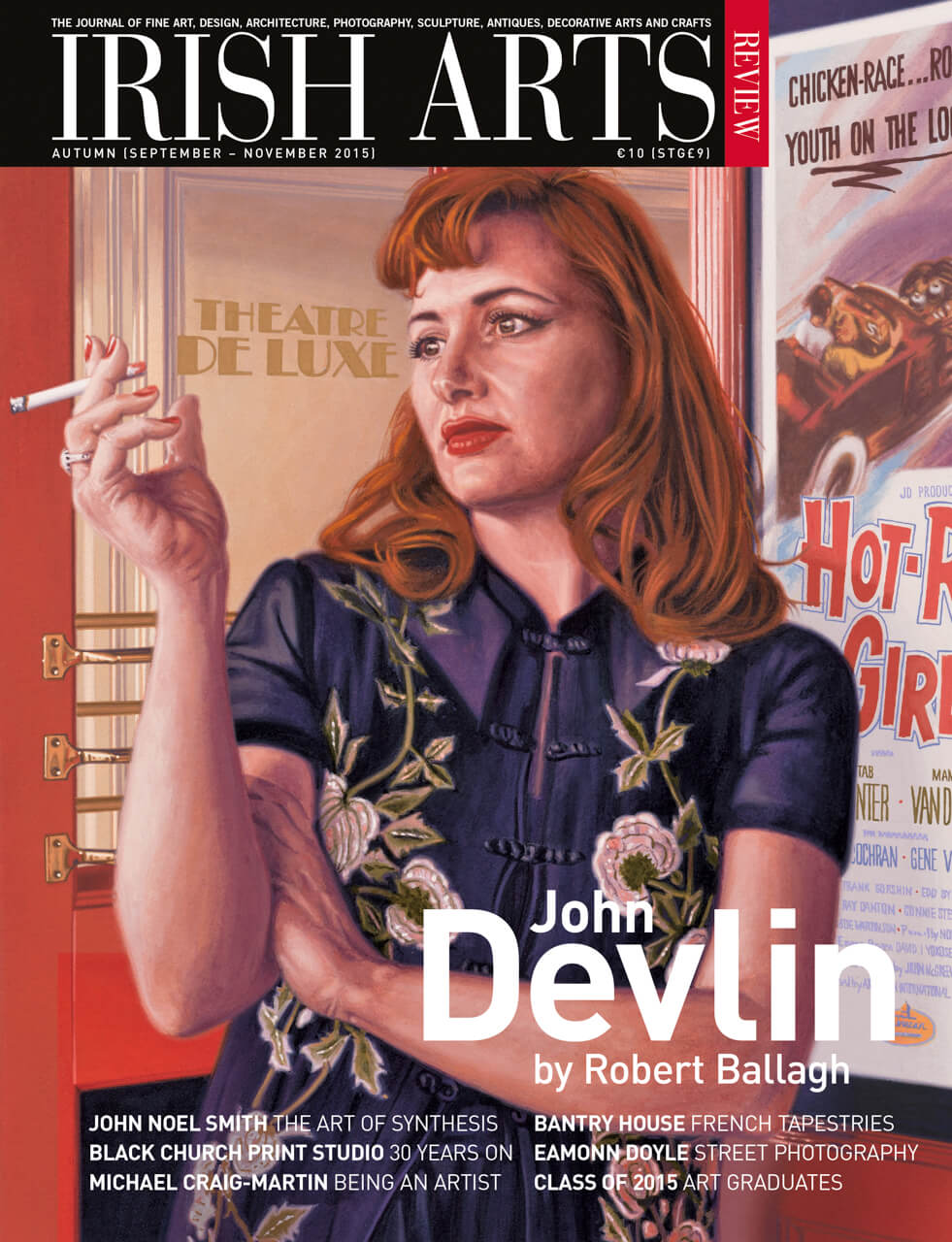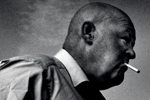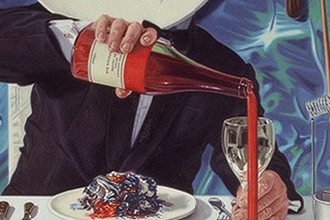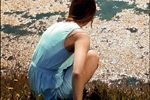
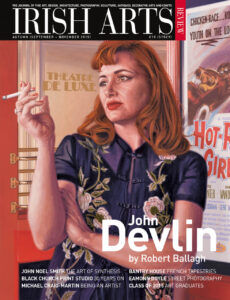
Gerry Walker welcomes the global vision seen at this year’s graduate exhibitions as Ireland’s nascent multiculturalism provides fertile ground for some of this year’s brightest artistic talents
The cultural demographic of Ireland is evolving. Immigration can provide an impetus for significant change in most spheres of society. Within the arts this is becoming increasingly apparent. One may anticipate with a considerable degree of optimism the impact of an immigrant sensibility on the existing indigenous cultural milieu. Some examples are already in evidence in this year’s fine art graduate exhibitions.
In IADT D√∫n Laoghaire, film production continues to flourish. Hana Dirya, who was born in Somalia and is a refugee to this country, created a short film entitled Diving Within. The film focuses on the seemingly mundane activity of swimming in the sea at D√∫n Laoghaire, but is, in effect, a visual essay which explores issues around integration and the politics of difference.
NCAD painting student Riin Kaljurand, from Estonia, questions the social constraints inflicted on women in her statement derived in part from deconstructed Soviet magazine imagery and re-imagined in contemporary terms.
Installation work employing a synthesis of film, sound and sculpture produced by Slovenian student Enya Fortuna at the Crawford College of Art and Design [CIT] delivers a Marxist meditation on labour and consumption resulting in a work of great assurance. In the Dublin Institute of Technology [DIT] Karl Leonard uses video to capture a paradox with Vis[able], a visual essay exploring the coping strategies employed by people with sight impairment. In an attempt to envision the invisible he exposes popular prejudices associated with this condition.
GMIT [Letterfrack] specializes in Furniture Design. Michael Harris, from South Africa, produced a body of work that successfully fused digital technology with traditional carpentry skills. Harris brings a particular focus to bear on functionality and elegance and in so doing illustrates an additional common theme to this year’s coterie of graduates. When his furniture is described as an ‘investment of quiet and contemplation’, he is being placed astride the bogus fault line which still separates art and design.
In some minds a strong design commercial potential seems incompatible with the perceived debt that Art owes to self-expression.
This year’s design graduates give further evidence that the designed object need not be bereft of powerful emotive content. Graduating from the University of Ulster School of Architecture, Laura McClorey’s environmental project is designed to focus and celebrate with the use of local materials and natural lighting, the subterranean experience. Situated in a limestone quarry in Glenarm village, Co Antrim, it enlivens and revives a shaped landscape that constitutes the type of special space that good architects have always built and should be still building today.
LSAD fashion student Bridget Murphy develops this theme of enhanced emotive functionality in a collection of ‘Untitled forms’ based on imagery inspired by American abstract painter Franz Klein. This type of media ‘borrowing’ has frequently occurred in the past, often very successfully. At best it works well when synthesized conceptually and formally. At its worst it can appear as an afterthought intended to enhance the ‘wow of the now’ factor. In this case however the critical consensus suggests that Murphy’s work is convincingly edgy and well executed showing an assurance and independence of spirit that is the hallmark of the Limerick Fashion School.
The high achievers in the class of 2015 reflect the beginnings of a new cultural diversity within Ireland. Change is inevitable, but if we are fortunate then development may flow from that change. The erosion of false distinctions between the activities of art and design, of which there was a strong indication in last year’s graduate cohort, has been sustained in 2015.
Gerry Walker is a freelance writer and critic.
Click here to view the New Generation Artists Online Gallery in association with New Ireland Assurance.
Karl Leonard
BA (Hons) Photography, School of Media, Dublin Institute of Technology
‘Losing your sight is like losing someone you love, it’s a bereavement process.’ Vis(able), the final year project by DIT graduate Karl Leonard, opens with this quote by one of the project’s participants Gerry Kerr. Shifting between the private and public sphere, the video piece records the responses of four visually impaired participants to questions asked off-camera.
An inherent paradox lies at the project’s core: how can we picture something invisible? Leonard overcomes this challenge compellingly through focusing on each person’s unique coping mechanisms. From the technological (such as smartphone apps), to the haptic (such as folding paper money in specific ways in order to make it easier to decipher each note), the viewer learns how each person adapts to better function in society.
In the 1970s photographer Allan Sekula lambasted documentary photography for the violence it inflicts on its subjects by reducing them to ‘victims’. The ultimate strength in Leonard’s project is that it avoids such victimisation by giving voice to the participants. Rather than employing pity to elicit sympathy the video is grounded in a sense of empowerment, achievement and agency. This is highlighted in participant Marian Deane’s closing comment which wryly weaves notions of sight and power around one another. ‘You have to accept your fate because if you don’t you might as well lie down and die. But I’m not that kind of person – they’ll have to shoot me – and they better have a bloody good aim.’
Sarah Allen works at the Photographers’ Gallery in London.
Bridget Murphy
BA (Hons) Fashion Design, Limerick School of Art and Design (LIT)
Bridget Murphy, winner of the 2015 International Fashion Incubation Limerick Bursary will benefit from a €5,000 work placement with the London-based Irish designer Danielle Romeril.
First impressions of Bridget Murphy are of an articulate and quietly confident person. This opportunity, to be immediately engaged in the day-to-day realities of fashion practice, will build on that confidence and extend her learning in a very worthwhile way.
Her graduate collection, Untitled Forms, shows the designer’s ability to deliver meaningfully on a concept that was inspired by the American abstract expressionist painter Franz Kline.
There are layers of creativity here, not just in the visual impact of her use of colour but also in the textural aspects of her work. She creates an interesting interplay of materials using household paints, industrial tape and more traditional fashion fabrics in contrasts of matt and shine. The collection is both edgy and well executed. Significantly, it also contains elements that demonstrate strong commercial potential.
Murphy, like Kline, appears to appreciate the impact of imagery and emotion. This aspect of her work will serve her well as she seeks to engage consumers in a fiercely competitive and highly saturated marketplace.
There was an obvious rapport between ‘master’ and ‘apprentice’ – Romeril and Murphy – at the judging of this year’s award. Murphy however demonstrates a noticeably independent spirit – it is unlikely she will remain in anyone’s shadow for very long as she strives to deliver on a distinguished start to her career in fashion.
Eddie Shanahan is Chairperson of the Council of Irish Fashion Designers.
Michael Harris
BSc Furniture Design and Technology, GMIT Letterfrack
A native of South Africa, Michael Harris has just completed his degree in Furniture Design and Manufacture at GMIT Letterfrack, County Galway. Harris, a qualified Toolmaker, returned to full-time education in 2012 as a mature student. Driven by a desire to become a professional designer, Harris has innate design ability. From his early days as a student his talent for creating innovative design solutions was apparent; Stool 71 was created in his first year. Design process is followed in a formal way and the result is a beautiful reconciliation of ergonomics and motion. Harris moves with ease between designing innovative retail products like Bendibowl, and larger-scale pieces like his digital desk and coffee table.
Harris’ work combines modern digital technology and traditional timber joinery. As a second year student he won the Design and Craft Council’s Future Makers Student Design Award for his Digital Desk 21. The desk is a re-working of a traditional writing desk, resulting in a bright acrylic and ash desk for the digital age.
In his final year Harris created the Slice coffee table. Digital technology was again used to create a table that was as efficient as possible in the use of materials. In this design he created an innovative joining system so that the plywood material could be machined on the CNC. The table is delivered flat-packed and assembled using a simple clicking mechanism. As a first prototype it is an innovation that has the potential for future development.
Michael Harris is concerned with simplifying the process of how and where things are made. His attention is focused on local production and the creation of functional yet elegant products that are long lasting. It represents high levels of innovation and desirability with a sensibility in the creation of beautifully refined objects suited to today’s market.
Susan Rogers is a lecturer in Furniture and Design History at GMIT Letterfack.
Hanan Dirya
BA (Hons) in Film and Television Production, The National Film School at D√∫n Laoghaire Institute of Art, Design & Technology
Diving Within is a miniature portrait in blue, a carefully composed series of images, rich with symbolism and colour. The subject of this documentary is a Malaysian woman who has found a way of connecting with her new home in Ireland.
Sharena Abdullah swims. Each day she enters the cold water off D√∫n Laoghaire harbor and in this testing ritual she has found a comforting sense of freedom. She tells us that the cold water grounds her, reminds her of how insignificant she is in this great big watery world, while simultaneously, her swimming allows her to connect to an Irish community of swimmers.
This short documentary film is full of big ideas. Sharena’s reflections on her adopted country and on her faith, on the politics of women in Islam and on integration, on the Irish sea, are both modest and profound. There is nothing didactic about Diving Within. The film is always intimate and thoughtful, and it feels personal.
Hanan Dirya, the director, is also an immigrant and therefore she is in tune with her material. Her film swims gracefully around her subject. Hanan is interested in and enchanted by Sharena, in what she has to say and in how she manages to be both Malaysian and Irish. And like her protagionist, Hanan is clearly enchanted by the water, by the light and the horizon lines.
Hanan’s classmate, Marie-Valerie Jeantelot, edited the film with flair and a wonderful sense of rhythm, and together with the director of photography Eileen Timmons, these four women have created something very beautiful. Diving Within is a sensitive and visually hypnotic piece of filmmaking.
Hanan Dirya, was born in Afgooye, in Southern Somalia, she lived in Saudi Arabia before coming to Ireland as a refugee. From an early age she has been developing her interest in documentary and in representation and identity. Being here without her parents was like being born again, beginning a new history. Last year she became an Irish citizen and this year her film will play at festivals around the world, introducing and announcing an original new voice in Irish filmmaking.
Hanan is currently working on another short documentary. This time she will focus on a nomadic people in Somaliland and how they have benefited from technology such as solar energy to charge their phones and stay in touch with families and friends living in the city. It is another small story that gets us inside and behind the politics of difference.
Paul Freaney is Academic Tutor on the Film Degree Programme at the National Film School at IADT.
Laura McClorey
BA (Hons) Architecture, University of Ulster
The site for Laura McClorey’s project for a stonemason’s works is, appropriately, a disused limestone quarry at the southern edge of Glenarm village, on the Co Antrim coast.
What remains of the quarry today is a steep, cratered, white-stoned landscape, slowly being reclaimed by nature, while the shell of a large mill building and a tall red brick chimney looms, a well-known local landmark.
Rejecting the idea of another ‘object’ building, Laura built the spaces of the stonemason’s works into rather than onto the site. It seemed fitting, even poetic, that a stonemason’s workshop could become part of the ground. The limestone has already been carved, sculpted and shaped on a grand scale.
The curious landscape continues over these spaces, as a roof, now part of a walking route through the quarry. As the building steps up the slope so does the landscape over it, giving elevated views over the sea, which get better as one climbs higher. The roof, not walls, divide public space from private.
Below, craftsmen are working stone in terraced spaces arranged around top-lit courtyards, exporting artefacts again from this site. The internal environment is earth (rock) sheltered, with the materials and the method of natural lighting designed to focus and celebrate the subterranean experience.
Our experience of real places is the result of a complex synthesis of sensory information. Designing great places is the architect’s goal, the poetic union between subject (the perceiver) and object (the perceived). Laura’s proposal, though it will never be built, would probably be a great place.
Jim Luke is a lecturer at the Belfast School of Architecture,
University of Ulster.
Chris Hayes
First-Class BA Honours Degree in Fine Art (Painting).
Fine Art Department, Limerick School of Art and Design (LIT)
In the painting department of Limerick School of Art & Design, Chris Hayes tackles the pervasive influence of smart technologies on our lives, bringing to mind Hito Steyerl’s collection of essays, The Wretched of the Screen. Smart, but for whom? The Utopian dream of an open and democratic platform for communication has been sold on as profit-making tools of surveillance – a lifestyle choice with which we are ultimately complicit. The distinction between real life and online life has blurred, as data sets and algorithms are implemented to predict our every desire with Artificial Intuition.
Phones and drones are the two dominant motifs for Digital Skin: Icon for a Pre-Apocalyptic Cyber-Utopia, a two-part presentation of original oil paintings and a projection of edited stock footage onto a cylindrical semi-opaque material. Hayes notes that oil paint was a technology developed to describe human skin and to record the gestures of the artist. Anthropomorphism is suggested in the paintings of amputated hands with their hand-held devices held together by skin-describing glue. I go to take a photograph of the painting, for reference you see, and ‘beep!’‚Ķmy phone dies.
We are ‘networked dull’ the artist says. The promise of empowerment, of technological literacy, of connectivity fades gradually and with apathy. Even the ‘green screen’ explosions of Hayes’ video work illicit little shock or horror from viewers but wry smiles or shrugs of recognition. We wait to see however where the drone is leading us, what does it want us to see? Or not see? Digital Skin, where the digital becomes physical, and vice versa, is an excellent addition to current art practice and discussion on the future of machine intelligence – I look forward to seeing more from Chris Hayes.
Mary Conlon is a PhD candidate at Limerick School of Art & Design and Director of Ormston House, Limerick.
Etaoin O’Reilly
One year on, Neil Read catches up with the inaugural New Ireland Assurance Award winner
The last time I wrote about Etaoin O’Reilly she was planning to go to London for three months to work as a studio assistant for Kate Malone. She left in September 2014 and ultimately spent fifteen weeks in the city.
O’Reilly assisted Malone with elements of her new Magma series which were shown at ‘Collect 2015′, the annual international fair for the contemporary object at the Saatchi
Gallery. I met Malone there in May this year and she spoke very positively about Etaoin. The experience was mutual as Etaoin ‘would go back over in a heart beat’. Malone included her in all aspects of the studio from the day-to-day tasks involved in running a successful workshop to the sharing of crystalline glaze information, bringing her to art, craft and design fairs such as ‘Decorex International’ and ‘PAD’ and making regular visits to the V & A. Etaoin was introduced to other established makers and observed how Malone interacted with clients. This was an invaluable and formative experience for a young maker.
Since her return to Ireland Etaoin has been based at the Sculpture Factory in Cork where she is working on a new series of Buggaplants entitled Orcheetles to be exhibited next year. This autumn O’Reilly takes up a residency in ceramics at the National College of Art and Design in Dublin where she intends to further research the crystalline glaze techniques that she researched with Kate Malone.
Neil Read is former Head of Ceramics, Glass and Metals at the National College of Art and Design.
Enya Fortuna
BA (Hons) in Fine Art, CIT Crawford College of Art & Design
A Marxist meditation on labour and consumption allegorized through Slovenian myth, Enya Fortuna’s installation was extraordinary both in the scale of its ambition and the intricacy of its realization. Amidst a notably strong degree cohort, with some very assured film and projection installations, Fortuna’s work stood out by dint of its sophisticated production values. Where White Egrets Spawn was a coherent, immersive installation employing film, sound and sculptural elements to mesmeric effect. A looming, angular slide or shoot bisected the room at an angle, while a single spotlight picked out the crystalline qualities of a crumbled mound of rock salt piled against the wall.
The film, epic in scale, was shot on location in and around Lake Bled in north-western Slovenia, moving between limpid, gorgeously framed landscape shots, and hypnotically choreographed scenes set in a hyper modern office interior and a bizarre underground tunnel system. The accompanying sound-scape became a sculptural presence in itself, pressing in against the viewer, taking up palpable space. Fortuna also designed a series of performances which drew lyrical links between the sculptural elements and the film.
Echoing the staccato choreography used in the film, Fortuna slowly and methodically mined the pile of rock salt with a silver pick axe, before climbing the steep metal structure with exertion. Sound again was an important consideration; Fortuna’s breath and stillness creating tension between spectator and performer. For all of these complex disparate elements however, the overall impression was one of thoughtfully judged restraint and meticulous design which united the ensemble.
Enya Fortuna is the recipient of the Best Moving Image and Solo Show (Cork Film Centre), Art Fest Prize, Development Bursary Award (Cork Institute of Technology) and the Lismore Castle Shortlist Graduate Award.
Sarah Kelleher is an independent arts writer and a PhD candidate with the History of Art Department in UCC.
Joseph Heade
and Riin Kaljurand
BA (Hons) Fine Art, National College of Art and Design
The faculty of Fine art in NCAD has been renamed as the School of Fine Art. This change of nomenclature reflects a set of identity-based issues which remain as yet unresolved. The college is bedevilled by ongoing problems which have undermined both staff and student morale. Motivation and cohesion are among the main casualties. In an attempt to be seen to embrace a macro European context (witnessed in the edu-speak of the Fine Art catalogue foreword) NCAD would appear to have neglected its micro-constituency. This is the paradox which is manifest in the recent graduate show.
With some notable exceptions, the end-of-year exhibition reveals an overall lack of resoluteness which possibly reflects an institutional ennui borne of recent internal unrest. The mishandled episode of Shane Berkery’s nude drawing of the Director is symptomatic of a lack of internal cohesiveness and mutuality of purpose.
The keynote aspect of the show reveals an unsurprising preoccupation with sharing the private sphere of personal introspection and experience. Joseph Heade presents a series of gouache paintings which are evocative of Oriental prints and scrolls. The subject matter deals with a walk through Killarney National Park. He suggests that parks are designed places which we experience through controlled movement through fabricated pathways and vantage points. In a play with perspectives he presents faux Oriental viewpoints which, being at variance with western landscape depiction, challenge the nature of our orthodox perceptual experience. The fabricated illusion of the Oriental woodblock is neat and elegant, and consolidates the main content of the work which examines controlled aesthetic experience.
In complete contrast Riin Kaljurand, an Estonian national, chose to explore an ideological-political theme in her collaged acrylic paintings which select and recycle imagery from an Estonian Soviet-era magazine entitled Soviet Woman. Kaljurand has successfully separated the message from the medium with a series of work which shows her keen interpretative abilities. The underlying ideological principle argues that feminine societal roles are not biological inevitabilities but are socially constructed.
Fragmented magazine imagery, re-imagined in a three-dimensional acrylic collaged format, elucidates how both image and message can be readily manipulated to create social consensus. Her work, though modest in scale, is arresting, harking back as it does to an Agitprop ancestry. The success of the works is largely determined by the extent to which she has achieved that medium/message balance. In this writer’s view nothing was lost in the translation.
Joseph Heade has been awarded the New Ireland Assurance Graduate Award 2015.
Gerry Walker is a freelance writer and critic.
The New Generation Artists Online Gallery, in association with New Ireland Assurance, is a unique initiative that brings together the work of the class of 2015 art graduates from around Ireland. The objective of the New Generation Artists Online Gallery is to support art graduates and provide a platform for their work at a critical juncture in their careers. The work of the graduates featured in this edition, together with work from graduates of art colleges around Ireland this year, may be viewed at www.irishartsreview.com
